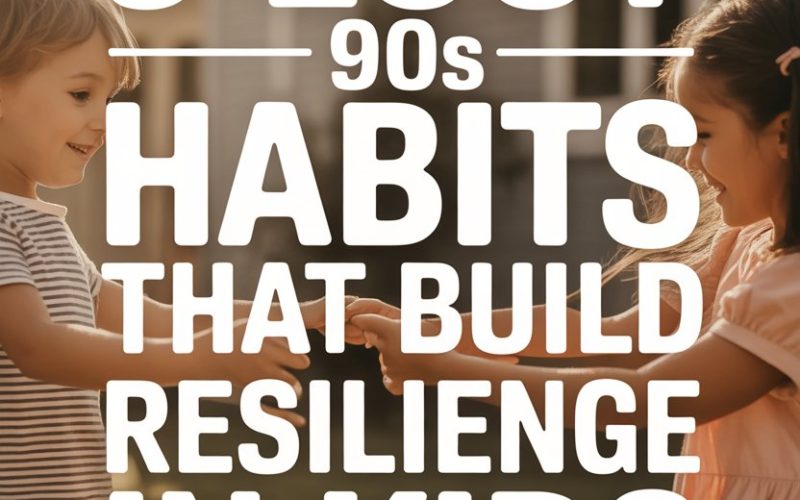Ever get nostalgic for the 90s?
Not for the fashion (cargo pants, anyone?), but for the way we seemed to toughen up and bounce back, armed with nothing but a spare house key and a vague sense of when dinner was.
Turns out, some of those “you’ll live” routines are exactly the grit-builders our kids need now—maybe more than ever.
Below, you’ll find three long-lost habits from the last millennium that genuinely build resilience in kids.
No time machine required—just a hint of courage, a dash of patience, and maybe a willingness to let things get a tiny bit messy.
1. The Art of Getting Bored (and Dealing With It)
Raise your hand if you ever muttered “I’m bored” in the 90s only to be met with “Go outside” or, worse, “Do some chores.”
Back then, boredom wasn’t a crisis; it was a launching pad for creativity, negotiation, or, at the very least, building elaborate couch forts.
Today’s kids are rarely given that luxury. There’s an app for everything—including the ones designed to banish boredom faster than you can say “screen time.”
But here’s the thing: boredom is a secret superpower.
Boredom forces kids to come up with their own entertainment. It encourages them to solve problems and invent games that don’t require adult supervision or a USB cable.
One 2018 study from the University of York found that unstructured downtime is a key ingredient in helping kids develop agency and creative thinking.
This doesn’t mean you have to let them wander the streets until dinner (please don’t). Try blocking out a chunk of time—no screens, no scheduled activities, no suggestions.
It might be rough at first (complaints are basically guaranteed), but let them stew in the discomfort of “what now?” That’s the moment when the magic happens: pillow mountains, Lego cities, impromptu backyard parades.
If your child’s first response is to beg for your phone or tablet, take a deep breath and hold the line. Remind them that you survived boredom (and somehow lived to tell the tale).
And if they’re really struggling, offer them the world’s most boring household task—folding laundry, matching socks, sweeping the porch.
Watch them suddenly remember how to play “spy mission” or invent a complicated game involving couch cushions and a laundry basket.
Boredom: it’s the gateway drug to resilience.
2. The Sacred After-School Free-For-All
Ah, the after-school hours—the sacred window between “I’m home!” and “Dinner’s ready!” In the 90s, this was peak kid time.
The rules were simple: get your snack (hopefully not just raw spaghetti), and then vanish until someone yelled your name out the door.
No sign-in sheets, no adult referees, no scheduled enrichment. Just a loosely supervised free-for-all.
Sometimes it looked like a game of backyard cricket with neighbours. Other days, it was a mass expedition to the local park, the only rule being “stick together and come back before dark.”
This unsupervised play did more than tire us out. It taught us how to negotiate rules, resolve arguments, take risks, and bounce back from skinned knees (and egos).
A study from the American Academy of Pediatrics found that free, child-led play is critical for building social and emotional resilience.
Are you picturing Lord of the Flies? It doesn’t have to be. Today, safety is real, and you’re probably not letting your six-year-old roam the streets solo. That’s fine.
But you can re-create the spirit of 90s after-school chaos with a few tweaks:
- Invite neighbours’ kids over (and keep snacks within arm’s reach).
- Head to the park together and give kids the freedom to invent games, sort out rules, and settle squabbles with minimal adult input.
- Resist the urge to referee every “No fair!” Instead, offer a sympathetic look from behind your cup of tea.
Kids will argue. They’ll get bored. They’ll figure it out. Every scraped knee, every failed negotiation, is a practice round for real-life resilience.
3. Solving Problems Without a Grown-Up Fixing Everything
Picture this: You’re eight, your toy breaks, and you bring it to your mum. She glances over, nods, and says, “Hmm, what do you think you could try?”
Cue the glare, cue the disappointment, cue… the wheels turning.
Back in the 90s, parents weren’t expected to fix every paper jam, broken shoelace, or playground spat.
We were encouraged to have a go ourselves, and if all else failed, to ask a sibling (who would probably charge us their entire stash of trading cards for “help”).
Allowing kids to struggle, fail, and solve problems gives them the “I can handle this” muscle.
It’s not about leaving them to flounder, but about holding back just enough to let them experiment—and sometimes fail—before swooping in with the parental toolkit.
Research from Stanford University’s Carol Dweck shows that kids who are allowed to face setbacks and work through challenges develop a growth mindset.
They’re more likely to see obstacles as temporary, not a full stop.
Try this tonight: When your child faces a problem (can’t reach the puzzle piece, can’t find the missing shoe, can’t get the jam lid off), instead of jumping straight to rescue, ask, “What could you try?”
Offer to brainstorm together, but resist the urge to do it for them.
Pro tip: You might need to sit on your hands. And yes, it might take longer.
But watching your child’s face when they finally get that jam lid off—priceless. That’s resilience, right there, sticky hands and all.
Why These 90s Habits Matter More Than Ever
It’s tempting to think our kids have it easier. But resilience isn’t about having the smoothest road—it’s about learning to climb over speed bumps.
The world they’re growing up in demands grit, flexibility, and the ability to bounce back from setbacks, big and small.
You don’t have to cancel all your activities or throw away every device (imagine the rebellion).
Just weave a bit of 90s grit into the daily routine: let them be bored sometimes, give them space for unstructured play, and resist the urge to fix every frustration.
Resilient kids don’t appear out of nowhere. They’re made, one boring afternoon, one playground spat, one sticky jam jar at a time.
Go on—try it. You’ve got this (and so do they).





